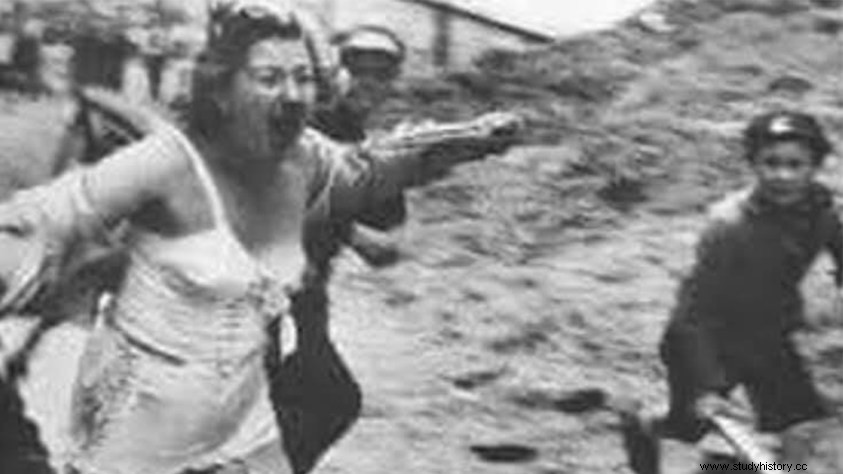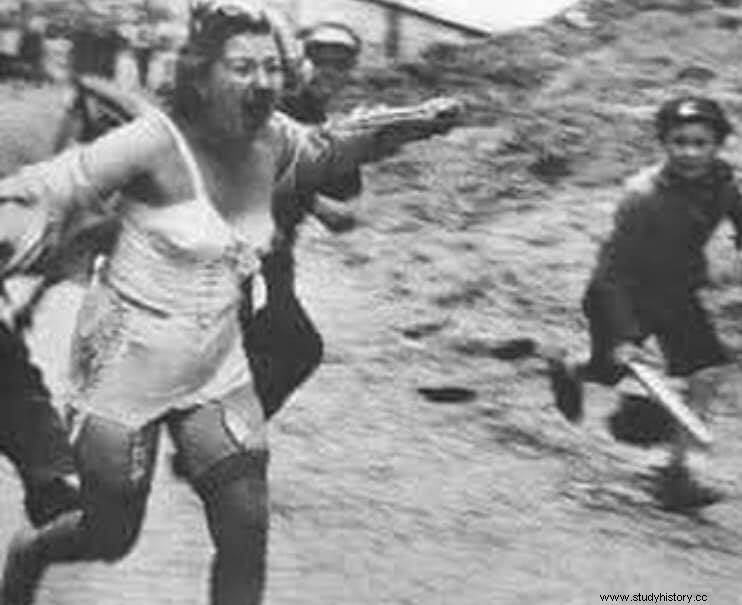
We are located in Lwowski (Lviv) , for now, I won't tell you when. In the photo we can see a Jewish woman, half-naked and bleeding, chased by some "men" and I don't think it is necessary to explain what their intentions are or what the woman's destiny will be, but if you really care, it starts with a rape and ends with la a murder death.
The woman's fault? apparently, being born a Jewish woman, in Lviv, between 1881 and 1945, and having been an adult during a Poogrom.
“Pogrom” is a Russian-derived word meaning “devastation” and generally indicates popular uprisings against ethnic and religious minorities, in particular between 1881 and 1943, in the world on the border with Russia, there will be numerous pogroms / popular uprisings , of anti-Semitic origin.
The Jewish population of some cities such as Lwowski or Černobyl , in the twentieth century, they dealt with several pogroms, of anti-Semitic origin, some of which in a Soviet climate and others, in a third reich climate.

In the photo, we witness the ferocity of a pogrom, through its victims, we see a half-naked woman chased by men in arms, but we also see more, in addition to men we also see a child, holding a stick, chasing the woman amused, the child is evident from his gaze that he is not understanding what is happening at that moment, but he would have assimilated that hatred, through what for him was a moment of play.
I have not yet said when the photo was taken and I did not do it for a reason, scenes like this, there were thousands of them, both in 1918, during the Lwowski Pogrom , by the Poles, and in 1941, after the German Einsatzgruppen entered the city, by the collaborators of the Third Reich.
In October 1918, geographically speaking, Lwowski was in Poland, however, that year, in October, the Ukrainian National Council was created of Lviv, led by Jewhen Petruszewycz , a Ukrainian nationalist who in his manifesto proclaimed the birth of the "People's Republic of Western Ukraine" .
Jewhen Petruszewycz in his political action recognized the existence of numerous national minorities, including the Jewish one, which was exceptional and extremely rare for the time, since, since there was no Jewish nation, Jews were not recognized as a people by almost any nation in europe.
On November 1, 1918, the Jewish district was created in Lviv, in which, initially there was an armed garrison of pro-Ukrainian Jewish militias, of about 200 men and about 100 civilians (mostly women, elderly and children) .
Lviv, it should not be forgotten, at this moment it is a city split in two, crossed by armed clashes between two groups of nationalists, on the one hand the city is "Ukrainian" and on the other hand it is "Polish", and it is precisely in this climate of violence, division and intolerance, which started the problems for the Jewish community of Lviv or Lwowski or Lviv.
Without going too far, the Jews, who were recognized as a people by Ukraine, were accused by the Polish militias of having conspired together with the Ukrainian militias against Poland, and in a very short time they ended up unloading all sorts of responsibility for any disaster on the Jewish population. never happened to Lwowski in the past thousand years or so, triggering an escalation of violence that resulted in a popular uprising, by Polish nationalists, against the Jews of Lviv.
We do not know the exact number of victims, but we do know that at least 2000 Jews were murdered and about 4000 were reduced to death, moreover the witnesses also speak of numerous rapes, often occurred in the street and under the eyes of children.
We also know that at that time, Lviv was the third "Polish" city by number of Jewish citizens, according to the city registers of the time, Lviv was home to about 100,000 Jews. Also according to the city registers we also know that, in 1941 (more than 20 years later) about 200,000 Jews lived in Lviv, and this second data brings us to the " second ”Pogrom of Lviv, or that of 1941.
The pogrom began on 25 July 1941, when, following the murder of the Ukrainian leader Symon Petliura , some 2,000 Jews lost their lives in some "civilian" clashes in which the Jews of Lviv were attacked by German-speaking Polish nationalists, Third Reich collaborators and formed into armed city militias. We know from witnesses that large numbers of Jews were forced to march, at gunpoint, to the Jewish cemetery or Lunecki prison , where they were murdered. These events are known as “ The Days of Petliura ", And they represent are only the beginning of what would soon happen to the Jewish population of Lviv.
Not too long after, in fact, the collaborators of the third reich opened the gates of the city to the German troops and the einsatzgruppen , who entered the city and established the Jewish ghetto of Lwowski from 8 November 1941 , in practice a part of the city was fenced off, guarded by armed guards and inside the long corridor in barbed wire, about 100/120 thousand Jews would have been locked up between November 41 and June 43.
If you remember, I said a little while ago that in 1941 the Jewish population of Lviv was about 200,000 people, but about 100,000 would have ended up in the Lviv ghetto, and it is curious to note that, one hundred thousand, is also the number of Jews in Lviv in the 1918. This data tells us many things, but I leave the necessary deductions to you.
But let's go back to the photo that allowed me to open a parenthesis on the pogroms in Lviv, of 1918 and 1941. I started from that photo, and I wanted to tell both episodes because they are connected through the child in the photo.
The photograph was taken during the 1918 Pogrom, and as I said, that child would have assimilated that violence, that intolerance, that visceral hatred for the Jewish population, through play. That child grew up hating Jews and as an adult, 20 years later, when he was confronted with a state, such as the Third Reich, which spoke to him of the superiority of the Aryan race, and promised Jewish extermination, he would have made certain choices that would have pushed to volunteer in pro-Nazi militias, becoming a Polish collaborator of the Third Reich.
I wanted to tell both pogroms for another reason too, the 1918 Lviv pogrom is often referred to as a "Soviet" pogrom , although, as we have seen, this is not exactly the case.
The reason why the pogrom of 1918 is often referred to as a pogrom of Soviet origin is partly due to the term "pogrom", it is a Russian term and this automatically shifts the attention to the Soviet Union, after all, the pogrom of the 1941, it is not always called a pogrom. Furthermore, in 1918 the Soviet Union already existed, but unlike in 1941, the Third Reich did not exist, and if it is true that, if we talk about Jews in the Soviet Union, these, at least until the 1980s, were strongly discriminated against and often persecuted and it is equally true that Russia is the birthplace of the false historian of the protocols of the Elders of Zion , it is also true that, although the USSR was a strongly anti-Semitic nation, it practiced anti-Semitism away from the spotlight, and did not flaunt it in the streets.
All these speculative theories at the end of the fair mean little or nothing, and there is only one really significant element in the whole story, namely that the architects of the 1918 Pogrom were not Bolshevik and pro-Soviet militants , but German-speaking Polish nationalists .
And in my opinion it is important to underline that precisely these groups, in the 1930s, would have totally embraced the anti-Semitic theories of the nascent German National Socialism , to the point of producing a new anti-Semitic pogrom, alongside the SS, in 1941, a pogrom that would have led to the Nazi occupation of Lviv and the birth of the city's Jewish ghetto.
